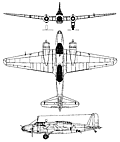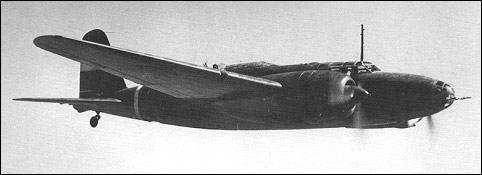|
| The Mitsubishi Ki-21 (Army Type 97
Heavy Bomber) was produced by engineers
Nakata and Ozawa in response
to an operational specification
issued by the Air Headquarters
(Daihonei) of the JAAF on 15 February
1936. The first of two prototypes flew
on 18 December 1936, the first production
model being the Mitsubishi Ki-21-
Ia (Army Type 97 Model 1A). Because
of production bottlenecks it was not
until the end of 1939 that Ki-21-la bombers
equipped the first JAAF unit, the
60th Hikosentai (air regiment) based in
China, in totality; the next unit to be
equipped was the 61st Sentai. Early
lessons learned over China demonstrated
lack of firepower and protection,
and the Ki-21-Ib and Ki-21-Ic subvariants
had extra armour, additional
7.7mm Type 89 machine-guns,
more fuel and larger bomb-bays. The
engines were 634kW Nakajima
Ha-5 KAI radials. By the time of
the outbreak of war in December 1941,
the majority of the Mitsubishi Ki-21-Ia,
Ki-21-Ib and Ki-21-Ic bombers had
been relegated to second-line duties,
or to service as operational bomber
trainers. First-line bomber sentais had
by now received the more powerful
Ki-21-II, with 1119kW Mitsubishi
Ha-101 engines in modified
Cowlings; production models in service
in 1941 were the Ki-21-IIa (Army
Type 97 Heavy Bomber Model 2A),
and the Ki-21-IIb which had a pedal-operated
dorsal turret with one 12.7mm Type 1 heavy machine gun.
Three sentais remained in Japan,
Korea and in Manchuria when the
Japanese high command went to war
in South East Asia. For operations over
the Philippines the JAAF's 5th Air
Group, based in Formosa, mustered
the 14th and 62nd Hikosentais; these
went into action early on the morning
of 8 December 1941 striking at Aparri,
Tuguegarao, Vigan and other targets
in Luzon. Mitsubishi Ki-21s of the 3rd
Air Group, based in French Indo-
China, were earmarked for bombing
strikes against Siam (Thailand) and
Malaya: units were the 12th, 60th and
98th Hikosentais. These smashed RAF
and RAAF facilities at Alor Star, Sungei
Patani and Butterworth, being
escorted by Nakajima Ki-27 and Ki-43
fighters. In the flush of Japanese victory
in 1941-2 the Mitsubishi Ki-21, codenamed
'Sally', performed well; only
over Rangoon over December 1941
and January 1942 did the Ki-21s suffer
heavy casualties. The Ki-21-IIb was the
final model to enter service, which was
seen on all fronts in the Pacific and Far
East theatres. Some 2,064 Ki-21s were
built.

| MODEL | Ki-21-Ia |
| CREW | 5 |
| ENGINE | 2 x Army Type 97, 710kW |
| WEIGHTS |
| Take-off weight | 7492-7916 kg | 16517 - 17452 lb |
| Empty weight | 4691 kg | 10342 lb |
| DIMENSIONS |
| Wingspan | 22.5 m | 74 ft 10 in |
| Length | 16 m | 53 ft 6 in |
| Height | 4.35 m | 14 ft 3 in |
| Wing area | 69.6 m2 | 749.17 sq ft |
| PERFORMANCE |
| Max. speed | 432 km/h | 268 mph |
| Ceiling | 8600 m | 28200 ft |
| Range w/max.fuel | 2700 km | 1678 miles |
| Range w/max payload | 1500 km | 932 miles |
| ARMAMENT | 3 x 7.7mm machine-guns, 750-1000kg of bombs |
 | A three-view drawing (752 x 891) |
| Madanmohan, e-mail, 02.09.2016 23:33 I want to know how many Mitsubishi KI21 sally model planes? How many met accidents ? Now where it located? reply | | TARIT BOSE, e-mail, 23.04.2012 23:29 I would be interested to know how many persons could travel by this aircraft (besides crews) and if you know the sitting arrangement of the passengers. Thanks for the reply. reply | | Jose, e-mail, 04.07.2011 06:06 Do you know any model about Mitsubishi ki-21? reply | | Robert Schillo, e-mail, 07.09.2008 01:01 I have a compass that came from one a Mi 21 bomber. The data plate reads Emperor's reign Showa 16 serial# 10683 with the Army star on plate. I'm interested in finding out more about this piece, origin and possible value. reply |
|
Do you have any comments?
|
| 
COMPANY
PROFILE
All the World's Rotorcraft
|








